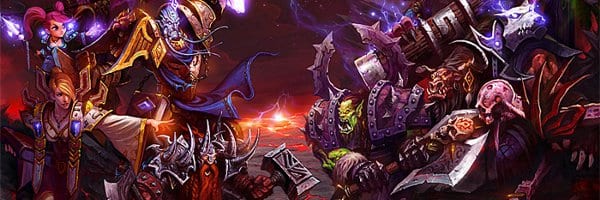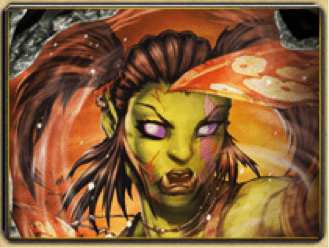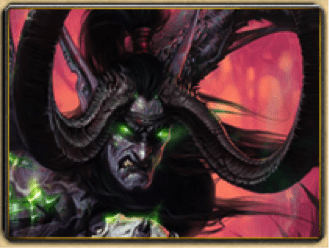Cheers'oh, buddy! Before I start my class on Alignments, I will introduce myself. I am Ekony, a troll (being a Troll does not have to be bad ¬¬)
Perhaps you have noticed from the title (or not) but I come to tell you about the role, a great world that can be developed in WoW. By custom, the role was paired with video console games or games for "weirdos", so to speak, but once you enter the role, personally for me, PvP or PvE is missing something, it lacks essence, the lack of a soul, so to speak.
Today, I will talk about the alignments that a character can have at the time of being created, an essential part in the world of the role and that will influence the interpretation of the character.

In the first installment, we talked about the Basics of the Alignment and how our character defines the different types of Alignments that we choose. In this second and last installment about the Alignments, we will talk about the 9 combinations that can define a character.

LEGAL GOOD
Archetype: the Crusader.
Combine honor and compassion for the innocent. These types of characters fervently support society and its laws, believing that they have been created for the good of all.
The character is honest and benevolent. They will act within the system to try to improve it and they strive to bring order wherever they go. They combine their commitment to fighting evil with an iron discipline, living according to a strict code of honor or according to the rules set by the deity of Good they serve. These characters will come to act with total disregard for their own lives for following these codes.
In any case, it must be taken into account that blind obedience to the laws is not an obligatory attribute for good legal characters. For example, a paladin does not violate his alignment if he chooses to take up arms against an usurper on behalf of the dethroned king he serves, even if this violates any sedition rules that the usurper may have established. That is to say, in general the character prefers a life structured according to a compendium of rules that he can follow.
Examples of good legal characters are the incorruptible policeman, the politician or ruler who acts on behalf of his people, or the soldier who acts heroically by strictly obeying the rules of battle. In literature we can find various examples such as Obi-Wan Kenobi (Star Wars), Aragorn son of Arathorn (The Lord of the Rings) or the knight Sturm Brightblade (Dragonlance).
NEUTRAL GOOD
Archetype: the Benefactor.
Characters like this are good people who like to help others, but have no special predilection or rejection of order.
A character does not feel particularly obliged to do good because of laws or restrictions, but to do good himself. Generally, he will abide by the law, but he will not hesitate to break it if he believes that he is doing a greater good. You don't feel tied to any social system or order, and your need to help others may be stronger than any other consideration.
The characters are generally those who act in a detached way, such as members of the Red Cross or members of Doctors Without Borders, who do good without considering the side of those they assist.
In fantasy literature we can consider Gandalf (The Lord of the Rings) to be neutral good: he does not hesitate to break laws to do good, and he does not feel bound by legal or moral constraints. In the Dragonlance series we could take Tanis Half-elf as an example.
CHAOTIC GOOD
Archetype: the Rebel.
A character who acts according to the dictates of his conscience without taking into account what others may think of him. He is generous and benevolent, combining a good heart with a free spirit. He is very individualistic and denies laws, regulations or any social order. He hates people who bully and despot others.
Their actions are usually aimed at fighting against unjust governments and organizations, trying to liberate the oppressed. They avoid organized societies as much as possible, which in many cases leads them to lead the lives of nomads or hermits.
This profile fits with rebel leaders of the nobility fighting corrupt regimes, mercenaries who only work for people with good ends and, in general, anyone "who robs the rich to give it to the poor." Robin Hood, Zorro, A-Team or Tasslehoff Burrfoot (Dragonlance) are typical examples of good chaotic characters.

LEGAL NEUTRAL
Archetype: the Judge.
A Judge character is based on the rule of law, tradition, or personal code. Order, as opposed to chaos, is your moral compass. They usually live by their personal codes or support strong, organized governments that impose a strong vision of order for all of their subjects.
This character combines reliability and honor without opting for any moral aspect. This does not mean that a neutral legal character is immoral or amoral, but the moral aspects of the world (Good and Evil) take on a secondary role in the face of code, tradition and the dictates of logic.
The characters are usually civil servants, soldiers who blindly obey their orders or judges who rigidly adhere to the established rules. A good example of a neutral legal character is Gill Grissom from the television series CSI. For Grissom the important thing is the evidence, regardless of whether they incriminate or exonerate the suspect. Another good example is R. Daneel Olivaw, from the Isaac Asimov Foundation saga, for whom the welfare of Humanity could be achieved through order.
ABSOLUTE NEUTRAL
Archetype: the Indecisive.
The neutral alignment (both ethically and morally) lacks biases or compulsions toward either end of the scale. A character under this alignment will do at all times what he considers most appropriate without preferences for Good or Evil, or for Order and Chaos.
In general, it will consider that Good is better than Evil, out of pure pragmatism, but that will not make it advocate Good considering it in the abstract, or in a universal way.
This is the natural alignment of most sentient beings, such as humans. Animals and creatures with low intelligence also naturally have this alignment. It is difficult (if not impossible) to find characters in Fantasy literature who adhere to this alignment.
However, this alignment can present distinct archetypes.
Archetype: the Faithful of the Balance.
A pure neutral character views any ethical or moral extreme as extremely dangerous. He firmly believes in the middle ground as the best option and is a staunch defender of balance. His position is clearly neutral in the face of any conflict, which does not mean that he is constantly changing his moral perspective, which would make him a very untrustworthy character.
Pure neutral characters tend to advocate balance in the world and try to prevent any faction (over Good or Evil, or over Order and Chaos) from taking precedence over any other faction. They will fight the faction they consider to be the most powerful at any given time.
They will usually fight on the side of the underdog, depending on the circumstances. Given their balanced posture, they carefully avoid making value judgments.
The perfect example of this alignment is Gilean, god of balance in the Dragonlance saga. Astinus, Palanthas' librarian in the Dragonlance saga is another perfect example of pure neutrality.
Archetype: the Druid.
In Advanced Dungeons & Dragons all druids are neutral. This alignment constitutes the central axis of the philosophy of every Druid.
The main objective of a druid is to protect Nature in all its forms (plants, animals, large-scale ecology, etc.), all elements without ethical or moral alignment. A druid will do whatever it takes to protect them.
Druidic orders act to maintain balance between the various alignments of the world. However, they are aware that any act, including their own, affects the Balance, but they consider these frictions between alignments as the driving force of the world.
When a druid is faced with a difficult ethical or moral decision, they often choose the solution that best serves nature in the long run.
A good example of a Druidic neutral character is Barbol, the Ent that appears in The Lord of the Rings, as his priority is caring for the trees in Fangorn Forest.
NEUTRAL CHAOTIC
Archetype: the Free Spirit.
A neutral chaotic character considers himself free from the constraints of society and is not compelled to practice the Good.
Neutral chaotic characters follow their impulses and are strongly individualistic. They value their own freedom above all else, but will not strive for the freedom of others. They avoid authority, hate restrictions, and defy tradition.
Despite this, these types of characters do not act actively, at least intentionally, to upset organizations in an anarchic way, since for this they would have to have some type of moral motivation: Good to free others or Evil to do suffer others.
The chaotic neutral character is often unpredictable in his behavior towards other people, although he is sure to preserve his own life.
A smuggler who carries out petty theft and rents his services is the perfect example of this alignment. Han Solo (before joining the Rebel Alliance, in Star Wars) or the assassin Hugh "The Hand" is a good example.

LEGAL EVIL
Archetype: the Despot.
The evil legal character is intentionally and methodically devoted to despotic, organized, and cruel systems. They tend to take whatever they want within the limits set by their personal code of conduct, regardless of who they may harm in the process. They care about tradition, loyalty and order, but they do not care about freedom, dignity or life. He plays by the established rules, but has no mercy or compassion. He is comfortable in a strongly established hierarchy, wanting to rise up to rule, never to obey. They do not like to break their word, so they are usually very cautious when it comes to pawning their word, which they will only do if they perceive a clear benefit in their favor.
This reluctance to pawn the word has a double origin: on the one hand it is due to its nature, and on the other hand it is due to its dependence on the established order to protect itself from those who oppose it on the moral ground. Some characters with this alignment have taboos such as not killing themselves in cold blood, although they can use hitmen to do so, or not letting children get into trouble, if they can help it. They usually consider that these moral precepts place them above the rest of the villains.
Sometimes evil legal characters can zealously dedicate themselves to the cause of Evil with the same zeal that a paladin dedicates to the cause of Good. Beyond their natural inclination to cause harm to achieve their own goals, they indulge in Evil as an end in itself. They also tend to cause Evil as part of the goals of a deity or teacher.
Evil legal characters are often considered diabolical since demons are the embodiment of this alignment. A tyrant who writes laws for his convenience, a corrupt lawyer, a judge who uses the law to mask his reprehensible acts, or ruthless members of organized crime are all good examples of this alignment.
In literature we have examples like Randall Flagg, a character from Stephen King's novel Apocalypse. The Knights of the Order of Takhisis in the Dragonlance saga are also a good example of evil legal characters.
MALIGNANT NEUTRAL
Archetype: the Criminal.
The evil neutral character is pure pragmatism without honor and without variations in his moral compass. It sticks to the maxim "survival of the most gifted."
These types of characters will always do whatever it takes to get away with it. They only care about themselves. Their pulse does not tremble when it comes to killing, whether for profit, sport or convenience. He is not inclined to order and does not respect the laws, traditions or codes that would make him more noble in some sense. On the other hand, they are not particularly inclined towards conflict or war.
Some neutral evil characters have Evil as an ideal, performing evil acts to spread Evil, as an end in itself. They usually belong to societies or deities of Evil.
An evil neutral character is Evil in its purest form, a criminal without honor and beyond all redemption. Saruman, in The Lord of the Rings, is a good example of an evil neutral character.
EVIL CHAOTIC
Archetype: the Destroyer.
The chaotic evil character represents power without control, absolute selfishness without chains, totally outside the law.
These types of characters are only guided by their lust for power, hatred and thirst for destruction. He is violent, cruel, aggressive, unpredictable, ruthless, and brutal. Fortunately his plans are very messy, and every group he joins will be poorly organized.
They normally collaborate only through force, and as leaders they stay on top only as long as they are not killed. Demons are the paradigm of evil chaotic beings. Serial killers, for example, are evil chaotic characters. In literature we can consider Melkor, who appears in the Silmarillion, as a perfect example of being chaotic evil.
So far the class of alignments, I hope you have read it and taken notes for the time of creating a character used for the role. I wait for you in the next guide about Rol.
Greetings'h colleague'h